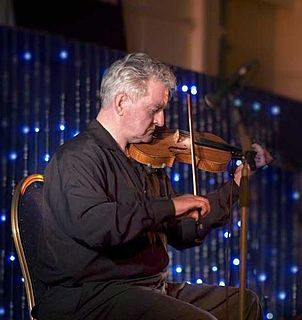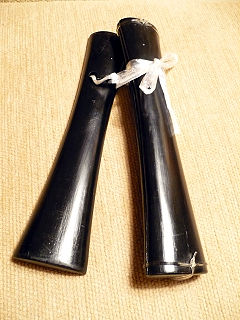
The Donegal fiddle tradition is the way of playing the fiddle that is traditional in County Donegal, Ireland. It is one of the distinct fiddle traditions within Irish traditional music.

Fiddling refers to the act of playing the fiddle, and fiddlers are musicians that play it. A fiddle is a bowed string musical instrument, most often a violin. It is a colloquial term for the violin, used by players in all genres including classical music. Although violins and fiddles are essentially synonymous, the style of the music played may determine specific construction differences between fiddles and classical violins. For example, fiddles may optionally be set up with a bridge with a flatter arch to reduce the range of bow-arm motion needed for techniques such as the double shuffle, a form of bariolage involving rapid alternation between pairs of adjacent strings. To produce a "brighter" tone, compared to the deeper tones of gut or synthetic core strings, fiddlers often use steel strings. The fiddle is part of many traditional (folk) styles, which are typically aural traditions—taught 'by ear' rather than via written music.

Chaozhou, alternatively transliterated as Chiuchow, Chaochow or Teochew, is a city in the eastern Guangdong province of China. It borders Shantou to the south, Jieyang to the southwest, Meizhou to the northwest, the province of Fujian to the east and the South China Sea to the southeast. It is administered as a prefecture-level city with a jurisdiction area of 3,110 square kilometres (1,200 sq mi) and a total population of 2,669,844.
Along with Shantou and Jieyang, Chaozhou is part of the Chaoshan region.
Cajun music, an emblematic music of Louisiana played by the Cajuns, is rooted in the ballads of the French-speaking Acadians of Canada. Cajun music is often mentioned in tandem with the Creole-based zydeco music, both of Acadiana origin, and both of which have influenced the other in many ways. These French Louisiana sounds have influenced American popular music for many decades, especially country music, and have influenced pop culture through mass media, such as television commercials.

A Hardanger fiddle is a traditional stringed instrument used originally to play the music of Norway. In modern designs, this type of fiddle is very similar to the violin, though with eight or nine strings and thinner wood. Four of the strings are strung and played like a violin, while the rest, aptly named understrings or sympathetic strings, resonate under the influence of the other four.

The zheng or guzheng, also known as a Chinese zither, is a Chinese plucked string instrument with a more than 2,500-year history. The modern guzheng commonly has 21 strings, is 64 inches (1.6 m) long, and is tuned in a major pentatonic scale. It has a large, resonant soundboard made from Paulownia. Other components are often made from other woods for structural or decorative reasons. Guzheng players often wear fingerpicks made from materials such as plastic, resin, tortoiseshell, or ivory on one or both hands.

Teochew is a Southern Min dialect spoken mainly by the Teochew people in the Chaoshan region of eastern Guangdong and by their diaspora around the world. It is sometimes referred to as Chiuchow, its Cantonese name, due to the english romanisation by English colonial officials and explorers. It is closely related to some dialects of Hokkien, as it shares some cognates and phonology with it, though both are not largely mutually intelligible.

Chaoshan or Teoswa is the cultural-linguistic region in the east of Guangdong, China that is developing into a single metropolis. This region is the origin of the Min Nan Chaoshan dialect (潮汕话). The region, also known as Chiusaan in Cantonese, consists of the cities Chaozhou, Jieyang and Shantou. It differs linguistically from the rest of Guangdong province which was historically dominated by Yue speakers, followed by Hakka and Leizhou Min speakers. However, Mandarin has recently become the dominant language in the region. It is historically important as the ancestral homeland of many Thais, Singaporeans, Malaysians and Indonesians of Chinese descent.
Bowed string instruments are a subcategory of string instruments that are played by a bow rubbing the strings. The bow rubbing the string causes vibration which the instrument emits as sound.

The music of the southern China has many features that are distinct from the rest of the country. For instance, many folk songs only use three notes. The region is home to significant populations of ethnic minorities, such as the Zhuang, Miao, She and Tai people.

Tihu (Pron:ˈtɪhuː) is a town and a town area committee established in 1951 in Nalbari district in the Indian state of Assam.
The ancient name of Tihu was 'Dihu'. According to Kalaguru Bishnu Prasad Rabha, 'DI' means 'water' and 'HU' means 'flow'. 'Dihu' is actually a word of Bodo language. The ancient name of the town came from the name of the river 'Dihu', which flows through the heart of Tihu Town. According to Assamese scholar, Banikanta Kakati, the name of the river transformed to 'Tihu' as time passed by. So the name of the town too changed to 'Tihu'.
The Teochew people are a Chinese people native to the historical Chaozhou prefecture of eastern Guangdong province who speak the Teochew dialect. Today, most Teochew people live outside China in Southeast Asia, especially in Singapore, Malaysia, Thailand, Cambodia, Vietnam, Philippines, and Indonesia. They can also be found almost anywhere in the world, including North America, Australia and France.

The yehu is a bowed string instrument in the huqin family of Chinese musical instruments. Ye means coconut and hu is short for huqin. It is used particularly in the southern coastal provinces of China and in Taiwan. The instrument's soundbox is made from a coconut shell, which is cut on the playing end and covered with a piece of coconut wood instead of the snakeskin commonly used on other huqin instruments such as the erhu or gaohu. As with most huqin the bow hair passes in between the two strings. Many players prefer to use silk strings rather than the more modern steel strings generally used for the erhu, giving the instrument a distinctly hollow, throaty timbre.

Teochew string music or Chaozhou xianshi is classed as a type of sizhu music although it typically uses stringed instruments only. It is found in northeastern Guangdong and parts of Fujian and also in regions with overseas Teochew populations, such as Malaysia, Singapore, Thailand, and the United States. The Chaoshan region of Guangdong, bordering on Fujian and comprising the cities of Chaozhou, Shantou and Jieyang, forms its own cultural sphere. Teahouses often accompany with Chaozhou music.

The paiban is a clapper made from several flat pieces of hardwood or bamboo, which is used in many different forms of Chinese music. There are many different types of paiban, and the instrument is also referred to as bǎn (板), tánbǎn, mùbǎn, or shūbǎn (书板). Typical materials used for the paiban include zitan, hongmu (红木), or hualimu, or bamboo, with the slats tied together loosely on one end with cord. It is held vertically by one hand and clapped together, producing a sharp clacking sound.
A qupai is the generic term for a fixed melody used in traditional Chinese music. The literal meaning is "named tune," "labeled melody," "titled tune," or "titled song". Qupai are relatively brief, most comprising between 20 and 70 measures in 2/4 meter. Many qupai are centuries old, but only a few of these have been handed down to the present.
Teochew woodcarving, or Chaozhou woodcarving, is a form of Chinese wood carving originating from the Tang Dynasty. It is very popular in Chaoshan, a region in the east of Guangdong. Teochew people used a great deal of Teochew wood carving in their splendid buildings.
Teochew or Chiuchow is an area in eastern Guangdong, China which contains Chaozhou, Shantou (Swatow) and Jieyang cities under new administrative division of PRC government made to former Teochew prefecture established in Qing dynasty.

















